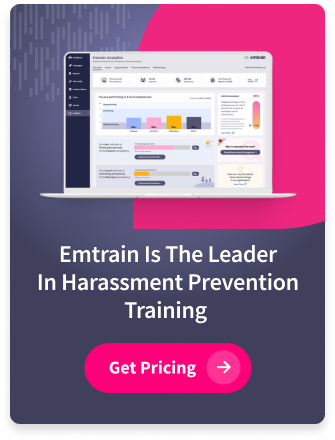Most organizations measure compliance training efficacy by a single data point: completion rates. But checking the box isn’t the same as building a healthy workplace. For HR leaders, compliance officers, and DEI program managers, the real question is: What is training actually telling us about our culture risks?
At Emtrain, we believe compliance training should not only teach—it should diagnose. By embedding questions, scenario-based learning, and behavioral feedback into every lesson, organizations can go beyond surface-level metrics and uncover meaningful insights into workplace dynamics.
The Hidden Risks Behind Compliance Failures
Employers face rising obligations under regulations like Title VII, SB 1343, and anti-bribery laws. Yet compliance failures often stem less from knowledge gaps and more from cultural blind spots:
- Unaddressed microaggressions that create patterns of exclusion.
- Teams hesitant to speak up about unsafe or unethical practices.
- Employees misunderstanding reporting channels or fearing retaliation.
When these signals go undetected, they escalate into employee relations claims, regulatory fines, and reputational harm.
Smarter Approaches to Training & Policy Design
Instead of relying only on post-training surveys, Emtrain’s compliance courses weave in embedded diagnostics:
- Scenario-based responses show how employees are likely to react in high-risk situations.
- Pulse questions capture perspectives on inclusion, respect, and trust.
- Aggregate analytics highlight patterns across teams, departments, and regions.
This shifts compliance training from passive information-sharing into an active listening tool—one that identifies risks early and informs better policy design.
Measuring Impact Beyond Check-the-Box Metrics
By surfacing root causes of misconduct, organizations can:
- Reduce employee relations claims.
- Target interventions where they matter most.
- Strengthen employee trust through transparency.
Instead of investing more in remediation after issues arise, leaders can focus on prevention—saving money while building a culture that attracts and retains talent.
Practical Moves to Strengthen Culture
- Audit your current metrics. Are you only tracking completion rates? Add behavioral insights.
- Embed culture questions. Integrate diagnostics into every compliance course.
- Analyze trends. Compare results across departments or geographies.
- Close the loop. Share findings with managers and provide coaching resources.
With the right compliance training strategy, organizations move from “check-the-box” to culture transformation.
Explore our case studies to see how peers are using training analytics to strengthen workplace culture.








